Ecosystem Partners
Nichicon collaborates with a growing network of ecosystem partners to expand the possibilities of energy storage using LTO rechargeable batteries. These partners integrate Nichicon batteries into a wide range of devices, often combining our batteries with energy harvesting technology for sustainable, maintenance-free solutions. Explore below to discover how our partners are putting Nichicon’s LTO battery technology to use.

ABLIC Inc.

ABLIC Inc.
| S-19192 | |
|---|---|
| Function | Battery monitoring (3 to 6cells) |
| Overcharge detection voltage | 2.500 V to 4.500 V |
| Overdischarge detection voltage | 1.500 V to 3.000 V |
| Current consumption | 18 µAmax. |
Schematic (Block Diagram) |
|
| S-8249 | |
|---|---|
| Function | Battery monitoring and cell balance |
| Overcharge detection voltage | 2.000 V to 4.600 V |
| Cell balance detection voltage | 2.000 V to 4.600 V |
| Current consumption | 2.0 µAmax. |
Schematic (Block Diagram) 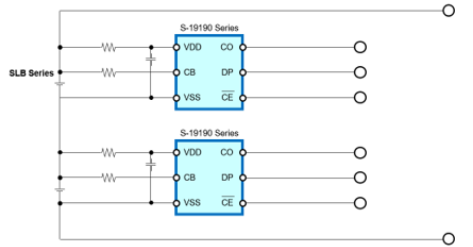 |
|
| S-8269B | |
|---|---|
| Function | Discharge/Charge overcurrent monitoring |
| Discharge overcurrent detection voltage 1 |
0.0030 V to 0.1000 V |
| Discharge overcurrent detection voltage 2 |
0.010 V to 0.100 V |
| Charge overcurrent detection voltage | −0.1000 V to −0.0030 V |
| Load short-circuiting detection voltage | 0.020 V to 0.100 V |
| Current consumption | 4.0 µAmax. |
Schematic (Block Diagram) |
|
| S-8215C | |
|---|---|
| Function | Battery protection (3 to 5cells) |
| Overcharge detection voltage | 2.700 V to 4.700 V |
| Current consumption | 0.7 µAmax. |
Schematic (Block Diagram)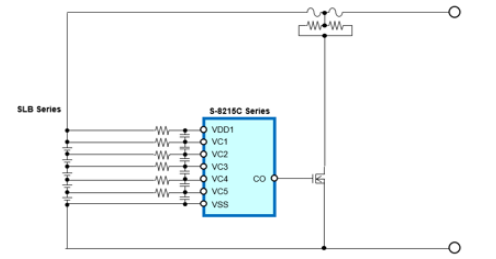 |
|
| S-8265C | |
|---|---|
| Function | Battery protection and cell balance(3 to 5cells) |
| Overcharge detection voltage | 2.700 V to 4.700 V |
| Cell balance detection voltage | 2.700 V to 4.650 V |
| Current consumption | 0.7 µAmax. |
Schematic (Block Diagram)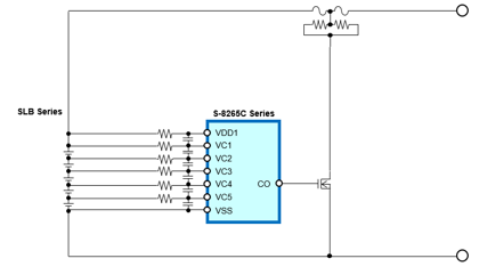 |
|
| S-1740/41 Series | |
|---|---|
| Function | LDO with supply voltage divided output for IoT |
| Operating voltage range | 1.5 V to 5.5 V |
| Output voltage range | 1.0 V to 3.5 V (selectable in 0.05 V steps) |
| Current consumption | 0.35 μA typ. (Ta=+25 °C) |
| Output voltage accuracy | ±1.0% (±15 mV at 1.0 V~1.45 V) |
| Output current | 100 mA |
| Voltage divider output(PMOUT) | VIN/2 (S-1740 series) VIN/3 (S-1741 series) |
Schematic (Block Diagram) |
|
| S-8354 Series | |
|---|---|
| Function | High efficiency at small load step up swiching regurator |
| Operating voltage range | 0.9 V (Iout=1 mA) to 10V |
| Current consumption | 18.7 µA typ. (at 3.3 V, 50 kHz) |
| Output voltage | 1.5 V to 6.5 V (VDD / VOUT separate type) |
| Switching current | 231 mA (at S-8354D30) |
| Soft start function | 6 ms typ. (at 50kHz) |
| Control type | PWM/PFM automatic switching |
Schematic (Block Diagram) |
|
| S-8474/S-8471/S-85S1A Series | |
|---|---|
| Function | Wireless power supply+Step down constant voltage charging and output. |
| Operating voltage range | 4.5 V to 6.5V (Wireless power supply) |
| Current consumption (S-85S1A) | 260 nA (quiescent current) |
| Output voltage (S-85S1A) | 0.7 V to 2.5 V, in 0.05 V steps 2.6 V to 3.9 V, in 0.1V steps |
| Output current | 100 mA |
| Control type (S-85S1A) | COT control |
Schematic (Block Diagram) |
|

Ambient Photonics

Ambient Photonics

Analog Devices Inc.

Analog Devices Inc.
| MAX1722x | |
|---|---|
| Function | Boost Converters |
| Input voltage range | 0.88 V~5.5 V |
| Minimum input voltage: MAX17220, MAX17224, MAX17226 | 0.4 V (ETP: enable transient protection) |
| Output voltage range | 1.8 V to 5 V |
| Operating temperature | -40 ℃ to +125 ℃ |
Application Circuit Diagram |
|
| MAX77827 | |
|---|---|
| Function | Buck-Boost Converter |
| Input voltage range | 1.8 V~5.5 V |
| Output voltage range | 2.3 V~5.3 V |
| Operating temperature | -40 ℃~+125 ℃ |
Application Circuit Diagram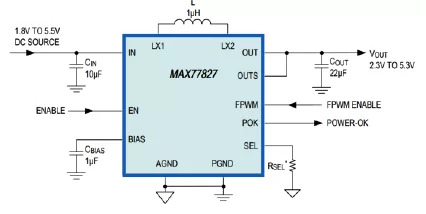 |
|
| LTC4079 | |
|---|---|
| Function | Linear Charger |
| Input voltage range | 2.7 V~60 V |
| Output voltage range (charging voltage) | 1.2 V~60 V |
| Charge current range | 10 mA~250 mA |
| Operating temperature | -40 ℃~+125 ℃ |
| Automatic recharge | Yes |
| Temperature qualified charging | Yes |
| Adjustable safety timer | Yes |
Application Circuit Diagram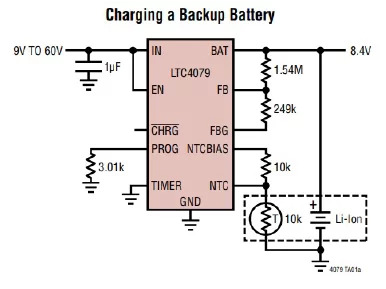 |
|

Atmosic

Atmosic

e-peas S.A.

e-peas S.A.
| AEM10330 | |
|---|---|
| Function | PMIC for photovoltalic energy harvesting |
| Input voltage range | 100 mV to 4.5 V |
| Cold start | 3 μW @ 275 mV |
| Input power range | 3 μW to 570 mW |
| Output current | 30 mA (low power mode) 60 mA (high power mode) Selectable load voltage from 1.2 V to 3.3 V |
| MPPT | Yes |
| Package | QFN40 5 mm x 5 mm |
Application Circuit Diagram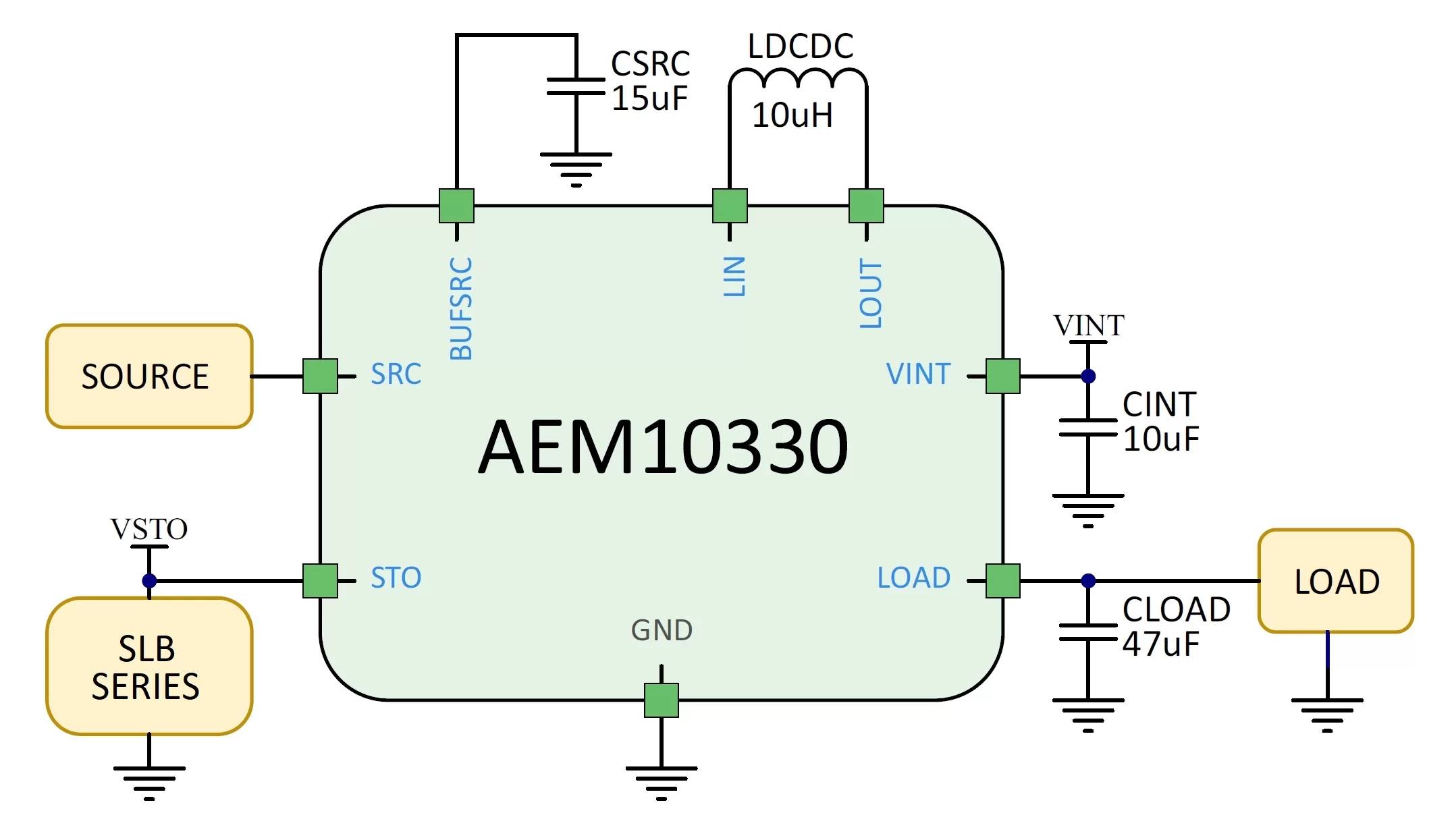 |
|
| AEM30330 | |
|---|---|
| Function | PMIC for vibration energy harvesting |
| Input voltage range | 100 mV to 4.5 V |
| Cold start | 3 μW @ 275 mV |
| Input power range | 3 μW to 570 mW |
| Output current | 30 mA (low power mode) 60mA (high power mode) Selectable load voltage from 1.2V to 3.3V |
| MPPT | Yes |
| Package | QFN40 5 mm x 5 mm |
Application Circuit Diagram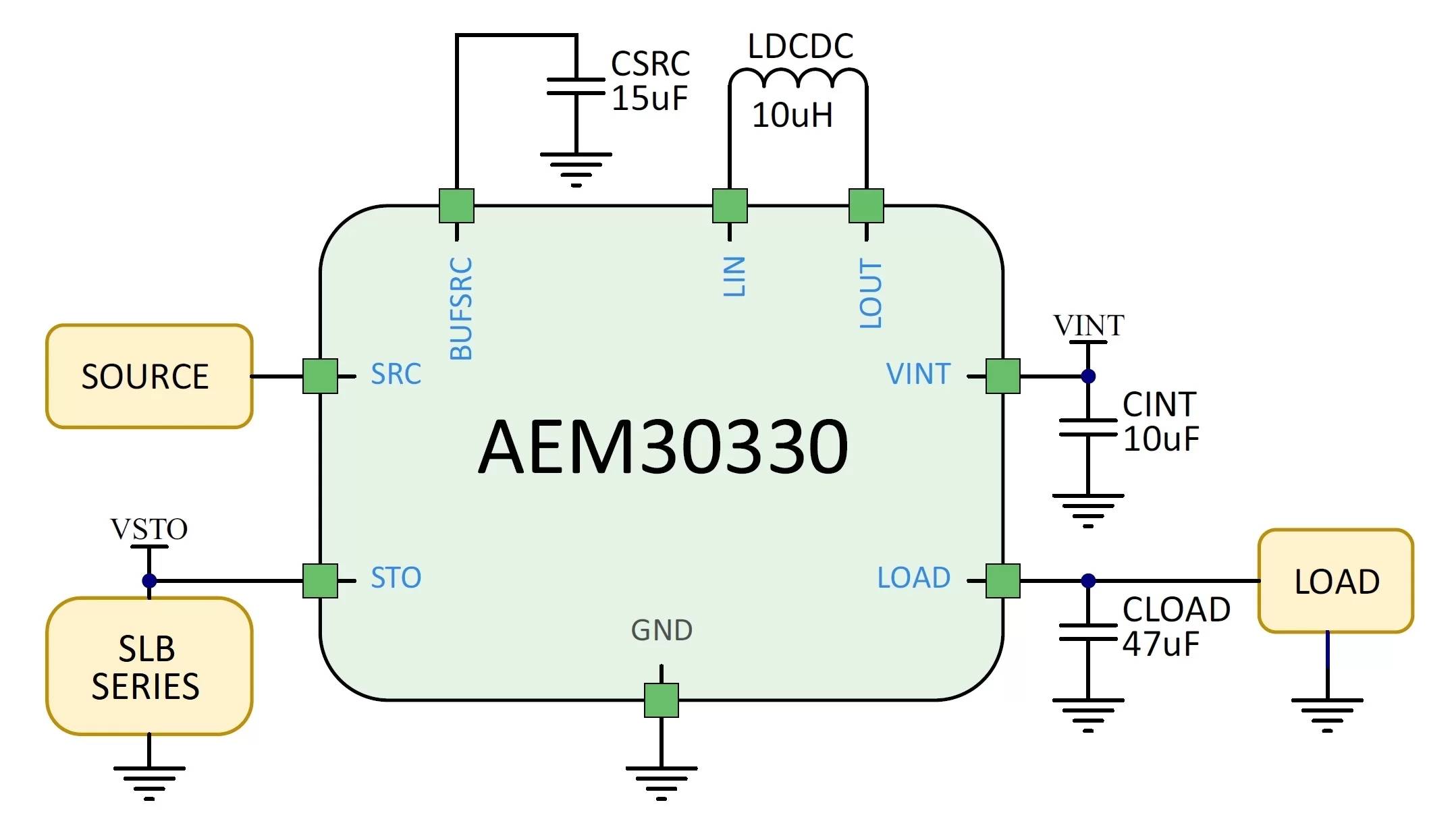 |
|
| AEM10300 | |
|---|---|
| Function | Photovoltalic energy harvesting battery charger |
| Input voltage range | 100 mV to 4.5 V |
| Cold start | 3 μW @ 275 mV |
| Input power range | 3 μW to 570 mW |
| Pout | N/A |
| MPPT | Yes |
| Package | QFN28 4 mm x 4 mm |
Application Circuit Diagram |
|
| AEM30300 | |
|---|---|
| Function | Vibration energy harvesting battery charger |
| Input voltage range | 100 mV to 4.5 V |
| Cold start | 3 μW @ 275 mV |
| Input power range | 3 μW to 570 mW |
| Pout | N/A |
| MPPT | Yes |
| Package | QFN28 4 mm x 4 mm |
Application Circuit Diagram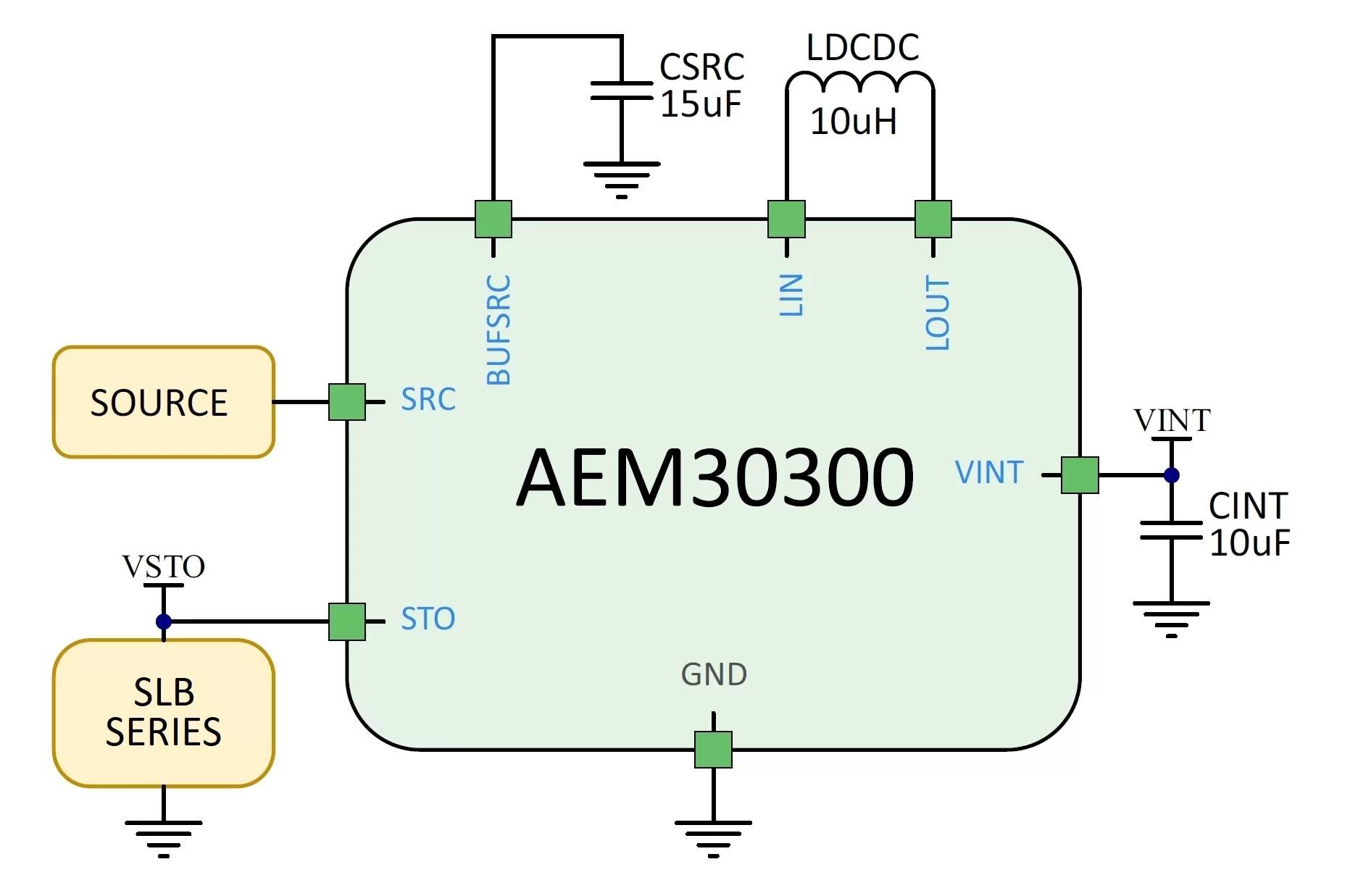 |
|

Epishine

Epishine

Exeger

Exeger

Lightricity

Lightricity
Lightricity manufactures and sells the world’s most efficient indoor PV technology (though it works excellently outdoors, too). It converts indoor light to energy with up to 35% efficiency—a more than six-fold improvement on conventional PV. A panel the size of a fingertip will power an IoT device forever. Even in extremely low indoor light, opening possibilities to power IoT devices not previously thought possible with indoor light. We offer two solutions. For those designing new connected devices, our customisable PV panels can be integrated into any low-power IoT device as an alternative to primary batteries. For IoT systems integrators, we offer off-the-shelf, easy-to-integrate, completely maintenance-free PV-powered sensors for many common measurement and tracking applications.
| Lightricity EXL1-1V20 indoor solar cell | Performance (200 lux white LED spectrum) |
|---|---|
| Size | 11.65 x 8.85 x 0.65 mm3 |
| Active area | 98 mm2 |
| Number of cells | 1 |
| Open circuit voltage | 1.15 V |
| Short circuit current | 22.7 µA |
| Operating voltage | 1.0 V |
| Operating current | 21.7 µA |
| Operating power | 21.7 µW |
| Power density (active area) | 22.1 µW/cm2 |
Matrix industries
Matrix industries
Nexperia
Nexperia
About Nexperia
Headquartered in the Netherlands, Nexperia is a global semiconductor company with a rich European history and over 14,000 employees across Europe, Asia, and the United States. As a leading expert in the development and production of essential semiconductors, Nexperia’s components enable the basic functionality of virtually every commercial electronic design in the world – from automotive and industrial to mobile and consumer applications.
About NEH7100 Energy Harvesting PMIC
NEH7100 is an inductorless Power Management IC that provides extended energy harvesting capabilities and power management features, including battery protection, LDO and USB charging. This device is a complete power management solution for energy harvesting, enabling engineers to optimize and extend the integration of LTO batteries enabling the device to be fully energy autonomous. Its target applications include wearables, remote controls, consumer electronics such as keyboards or smart tags, industrial sensors and asset tracking.
| Spec | NEH7100BU |
| Supported harvesters | PV cells, piezo, TEG, antennas |
| Input power range | 15 μW to 100 mW |
| Cold start | Yes |
| Storage element voltage | 0 V – 4.5 V |
| Boosting factor | 2, 4, 8, 16 |
| Maximum Power Point Tracking (MPPT) | Adapts within 0.5 s, adjustable to 64 s |
| Power management features | OVP, LVD, OCP, LDO, USB charging |
| Configurable through | Hard-coding; I2C |
.png)
Nisshinbo
.png)
Nisshinbo
| NC4650 | Application circuit diagram | |||||||
| Function | Ultra-Low Quiescent Current Boost Switching Regulator with Low Lipple Mode |
|||||||
| Input voltage range | 0.6V~5.5V |
|
||||||
| Startup voltage | 0.8V | |||||||
| Output voltage range | 1.8V~5.0V (Internal fixed) | |||||||
| Quiescent current (VOUT) | 70nA (Normal mode) 90µA (Low ripple mode) |
|||||||
| Efficiency | 85% (VIN=1.5V,VOUT=3.3V, IOUT=10µA) | |||||||
| Switch current limit | 1.0A (VSET≧2.5V) 0.6A (VSET<2.5V) |
|||||||
| Other functions | Soft start Manual switching between normal mode and low ripple mode via MODE pin |
|||||||
| Operating temperature | -40℃~85℃ | |||||||
| Feature |
|
|||||||
| Datasheet | https://www.nisshinbo-microdevices.co.jp/en/pdf/datasheet/nc4650-s-e.pdf | |||||||

ONiO

ONiO
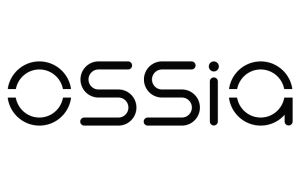
Ossia Inc.

Ossia Inc.

Powercast

Powercast

PowerFilm

PowerFilm
PowerFilm specializes in custom solar solutions meeting design, power-output, and timeline needs of customers. Controlling each step in engineering, design, and production, PowerFilm delivers the highest quality and performing systems. Our amorphous silicon functions at incredibly low light levels making it perfect for IoT, indoor, and many outdoor applications. Modules have been used for a wide range of applications including solar tents for the Army, powering electronics on a space exploration vehicle and custom asset tracking solutions. PowerFilm has been developing and manufacturing its unique flexible solar technology for nearly three decades, making it one of the few, and maybe the oldest, surviving solar manufacturers in the United States.
ONP2.4-15x94 Classic Application Series Solar Panel

Classic Application panels are lightweight, paper-thin, and durable. Their ultra-thin, flexible profile enables easy integration into devices for solar recharging or direct power. These panels do not have a UV-stabilized surface but are suitable for intermittent outdoor use. Classic Application Series panels are optimized to collect sunlight outdoors and are a small representation of PowerFilm’s wide range of custom options, including size, voltage, and more.
These panels are well suited to power the wireless devices and sensors of the emerging IoT industry and many other electronics. Sizes range from inches to feet squared with a standard thickness of 0.22 mm. This thin-film amorphous silicon flexible solar module is laminated with standard duty PET and foil tape contact terminals. It is well suited to collect direct sunlight and indirect light in shady areas. A long product lifetime can be achieved when the module is assembled with adequate moisture and UV mitigation. Custom panel options are available.
Electrical Specifications- 100% Sun: 18.6 mA at 2.4 V (44.7 mW); 25% Sun: 4.19mA at 2.4V (10.1 mW)
- Max Voc: 3. 7 V
- Average lsc: 24.2 mA
- f/b Laminate: 3 mil PET / 3 mil PET 3/16 in Copper Foil Busbar 2 mm x 2 mm
- Exposed Backside Contacts Thickness: 0.2 mm - 0.3 mm
- Appr. Weight: 0.40 g
- Operating Temperature: -25 °C to +65 °C
- Bend Radius: 1 inch fixed, 3 inch repetitive
- UV and Moisture Protection: Limited
INP3.6-24x44T Indoor Light Series Solar Panel
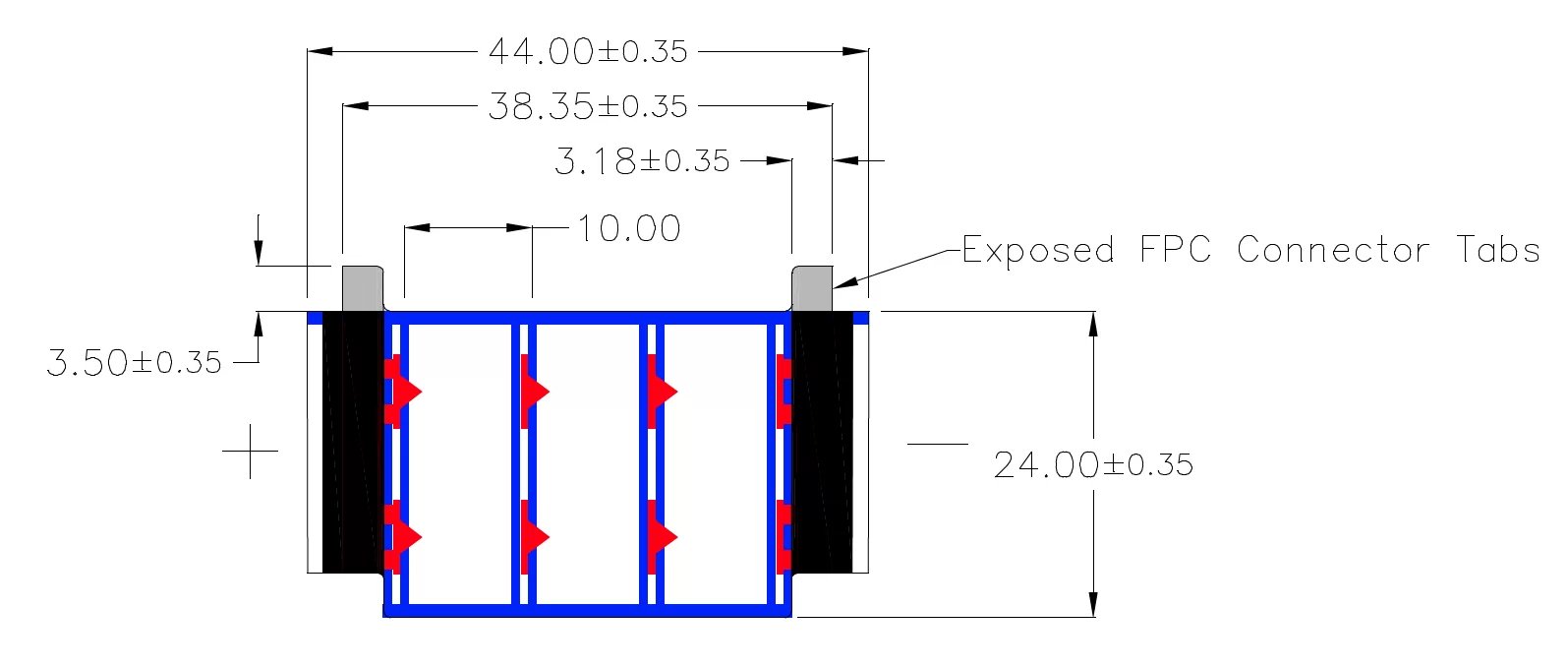 With industry-leading performance, these panels are ideal for integrating with ultra-low power wireless devices, sensors, and electronics. For application notes and examples, check out our Solar Development Kits, which make prototyping and experimenting with these panels simple. Indoor Light Series panels are compatible with all common indoor light sources, including LED, fluorescent, incandescent, halogen, and indirect sunlight. All panels are tested and are guaranteed to perform in dim 200 lux and brighter 1,000 lux environments. This thin-film amorphous silicon flexible indoor solar module is laminated with standard duty PET and foil tape contact terminals. It is well suited to collect artificial lighting in indoor settings such as warehouses, offices, and retail spaces. Custom panel options are available.
With industry-leading performance, these panels are ideal for integrating with ultra-low power wireless devices, sensors, and electronics. For application notes and examples, check out our Solar Development Kits, which make prototyping and experimenting with these panels simple. Indoor Light Series panels are compatible with all common indoor light sources, including LED, fluorescent, incandescent, halogen, and indirect sunlight. All panels are tested and are guaranteed to perform in dim 200 lux and brighter 1,000 lux environments. This thin-film amorphous silicon flexible indoor solar module is laminated with standard duty PET and foil tape contact terminals. It is well suited to collect artificial lighting in indoor settings such as warehouses, offices, and retail spaces. Custom panel options are available.
Electrical Specifications
- 1,000 Lux: 63.4 µA at 3.2 V (202.8 µW)
- 200 Lux: 13 µA at 2.4 V (31.2 µW)
- Max Voc: 5.55 V (Direct Sunlight)
- Average Isc: 9.8 mA. (Direct Sunlight)
Mechanical Specifications
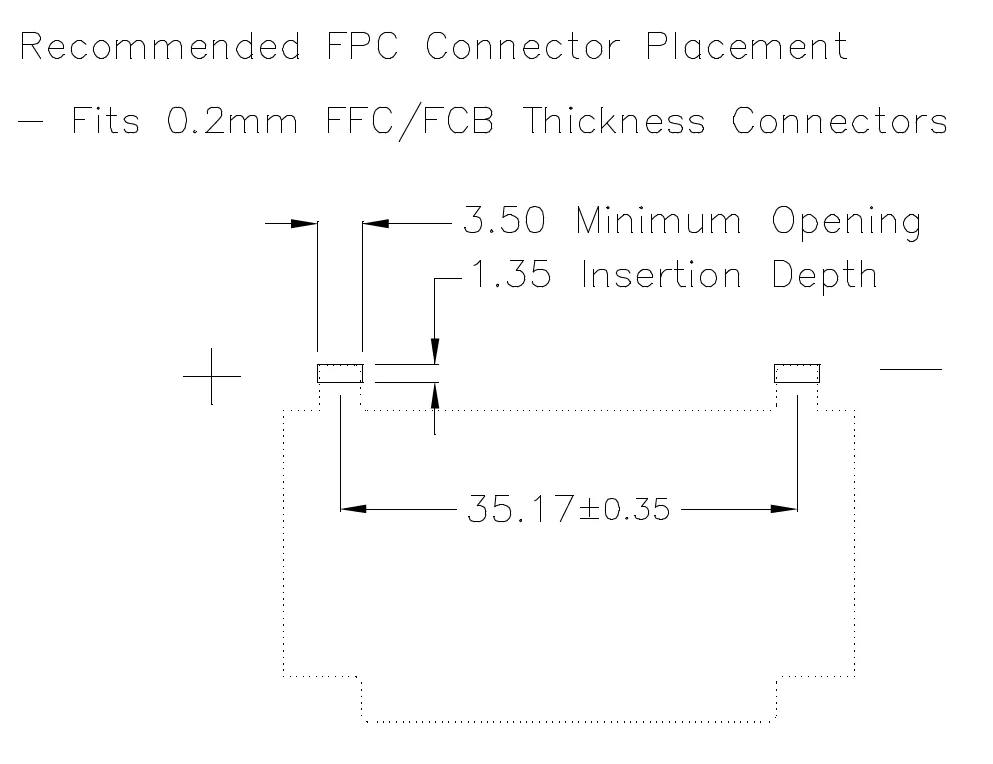
- f/b Laminate: 3 mil / 3mil PET 3/16 in Copper Foil Busbar with Black Thickness 0.22 mm
- Appr. Weight: 0.26 g
- Operating Temperature: -25 °C to +65 °C
- Bend Radius: 1 inch static, 3 inch repetitive
- UV and Moisture Protection: Limited
- Exposed 0.2 mm FPC Connector Tabs

Qoitech

Qoitech
| Otii Ace Pro | ||
|---|---|---|
| Function | The instrument that can precisely source and simultaneously measure voltage and current. It computes power and energy, and syncs with software output, enabling engineers and developers to easily see what drains the energy and optimize the battery life of their devices under test. | |
| Source (Voltage) | 0 V to 25 V | |
| Source (Power) | up to 30 W, 50 W peak | |
| Sink (Power) – requires Battery Toolbox license | up to 15 W, 125 W peak | |
| Current measurement | Resolution | 0.4 nA |
| Accuracy | ±(0.05% + 25 nA) | |
| Sample Rate | up to 50ksps | |
| Voltage measurement | Accuracy | ±(0.01% + 1 mV) |
| Sample rate | up to 50 ksps | |
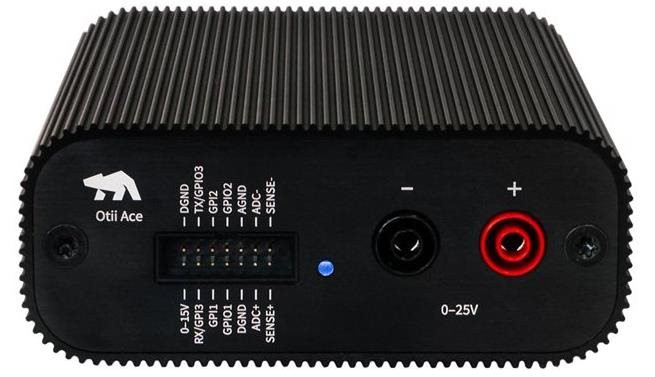.jpg?lang=en-US&width=300&height=172) |
||
| Otii Battery Toolbox | |
|---|---|
| Function | Otii Battery Toolbox (BT) is a software add-on that upgrades Otii Ace Pro to a powerful battery profiler and emulator. |
| Points in Emulation | as many as no of iterations |
| ESR Range (1) | up to 5 kΩ |
| ESR Resolution | down to 1 mΩ |
| Voc Range | 0 V to 25 V |
| Voc Resolution | 1 mV |
| Capacity Range | no limit |
| Capacity Resolution | 1 µAh |
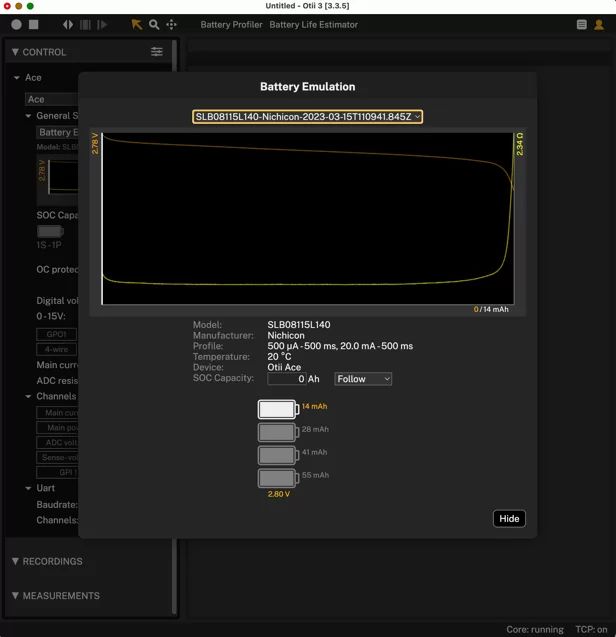 |
|

TOREX Semiconductor ltd.

TOREX Semiconductor ltd.
| XC6240 | |
|---|---|
| Feature | LDO for charge |
| Input Voltage | 1.5 V-6.0 V |
| Output voltage | 2.63 V (typ.) |
| Output Current | 150 mA |
| Current Consumption | 0.8 μA |
| VOUT sink current | 0.24 μA |
Circuit Diagram |
|
| XC6215 | |
|---|---|
| Feature | LDO for current limit |
| Input voltage | 1.5 V-6.0 V |
| Output voltage | 0.9 V-5.0 V |
| Output current | 200 mA |
| Current consumption | 0.8 μA |
Circuit Diagram |
|
| XC8109 | |
|---|---|
| Feature | Load SW with current limit IC |
| Input Voltage | 2.5 V-5.5 V |
| Current limit | 75 mA~ |
| Current consumption | 40 µA |
Circuit Diagram |
|
| XC6140 | |
|---|---|
| Feature | RESET to detect voltage drop |
| Input Voltage | 1.1 V-6.0 V |
| Detection voltage | 1.6 V-2.2 V |
| Release voltage | 2.475 V |
| Current consumption | 104 nA (detection) |
Circuit Diagram |
|

ROHM Semiconductor

ROHM Semiconductor
| BD5230NVX-2C | Application circuit diagram | ||||||||||||
| Function | Voltage detector for detecting battery voltage drop | |
|||||||||||
| Reset Active Voltage Range | 0.8V to 6V | ||||||||||||
| Detection voltage | 2.6 to 3.1V | ||||||||||||
| Hysteresis Voltage | Detection votaltage x 0.05 | ||||||||||||
| Circuit Current (OFF) [µA] | 230nA | ||||||||||||
| Circuit Current (OFF) [µA] | 270nA | ||||||||||||
| Operating temperature | -40~125℃ | ||||||||||||
| Datasheet | https://fscdn.rohm.com/en/products/databook/datasheet/ic/power/voltage_detector/bd52xxnvx-2c-e.pdf | ||||||||||||
| Product HP | https://www.rohm.com/products/power-management/voltage-detectors/adjustable-delay-time/bd5230nvx-2c-product#productDetail | ||||||||||||
| ML7661/ ML7660 | Application circuit diagram | ||||||||||||||||||||||||
| Function | 13.56MHz(NFC) Wireless charging LSI |
|
|||||||||||||||||||||||
| Power supply capacity | 1W | ||||||||||||||||||||||||
| Operating Frequency | 13.56MHz | ||||||||||||||||||||||||
| Operationg Voltage | 5V | ||||||||||||||||||||||||
| I/F | NFC Forum Type3 Tag SPI, I2C |
||||||||||||||||||||||||
| Operating Temperature | -40~85℃ | ||||||||||||||||||||||||
| Data Sheet | https://fscdn.rohm.com/lapis/en/products/databook/datasheet/ic/wpt/FEDL7661.pdf https://fscdn.rohm.com/lapis/en/products/databook/datasheet/ic/wpt/FEDL7660.pdf |
||||||||||||||||||||||||
| Product HP | https://www.rohm.com/lapis-tech/product/wireless-charging/ml7660_61 | ||||||||||||||||||||||||